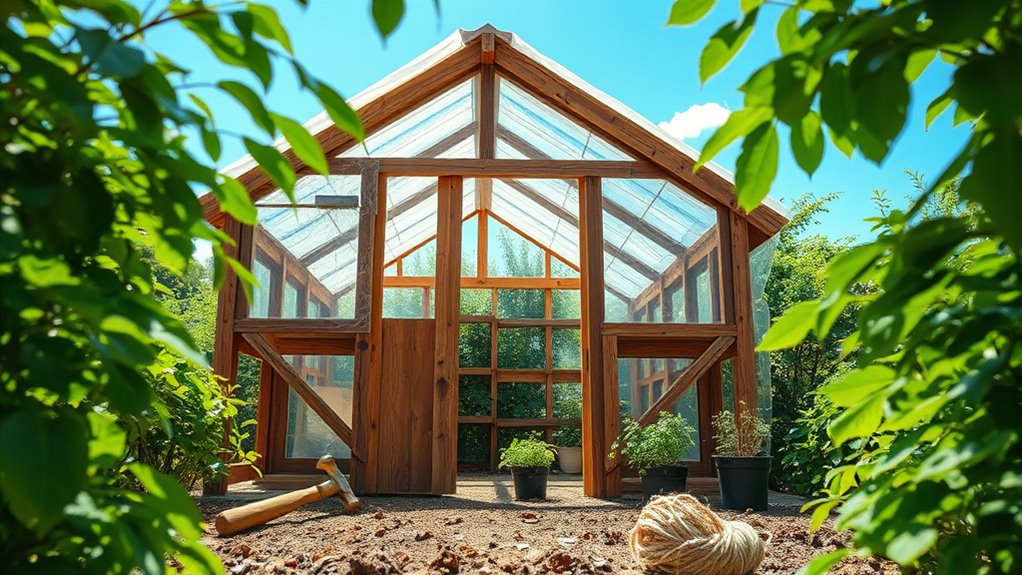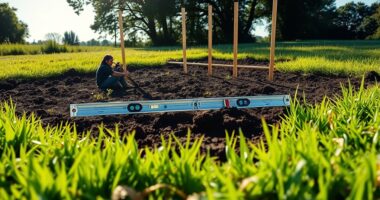Building a greenhouse on a budget is doable with careful planning. First, assess your space for sunlight and wind patterns. Choose cost-effective materials like repurposed windows or recycled polycarbonate panels. Simplify your design to cut down on costs and consider DIY methods for labor savings. Implement eco-friendly solutions, like rainwater collection, to reduce ongoing expenses. If you’d like to discover more tips and tricks for making your greenhouse project successful, you’ll want to keep exploring.
Key Takeaways
- Use free online plans and DIY techniques to eliminate design fees and labor costs.
- Repurpose materials like old windows and pallets to save on building supplies.
- Opt for cost-effective frame options such as recycled metal to maintain durability without breaking the bank.
- Implement rainwater collection systems to reduce irrigation costs and reliance on municipal water.
- Consider a modular greenhouse design for future expansions without significant financial strain.
Assessing Your Space for a Greenhouse

When evaluating your space for a greenhouse, how do you guarantee it meets your needs? Start by examining sunlight exposure, ensuring your site gets plenty of direct sunlight for ideal plant growth.
Next, consider wind patterns; positioning your greenhouse to minimize wind damage is essential.
Positioning your greenhouse strategically can significantly reduce wind damage and protect your plants.
Don’t overlook soil quality—aim for a pH between 5.5 and 6.5 for healthy crops.
Watch out for nearby structures or trees that could cast shade.
Evaluate your property size and check local zoning laws for compliance.
A slight slope aids air circulation and drainage, while level ground cuts initial grading costs.
Finally, plan for future expansion to accommodate growing gardening ambitions. Additionally, ensure that your greenhouse design incorporates proper ventilation techniques to maintain optimal growing conditions.
Choosing the Right Materials

Selecting the right materials for your greenhouse is essential for ensuring its longevity and effectiveness.
You’ll want to evaluate both frame and covering materials carefully.
Here’s a quick guide to help you choose:
- Frame Options:
- Wood: Natural and cost-effective, but watch for rot.
- PVC: Lightweight and affordable, though not very sturdy.
- Aluminum: Durable but pricier.
- Recycled Metal: Strong and often low-cost.
- Covering Materials:
- Polycarbonate Panels: Budget-friendly and durable.
- Polyethylene Film: Easy to install, but less durable.
- Glass: Great light transmission, yet heavy and expensive.
- Old Windows: Free or low-cost, provide good insulation.
Choosing the right materials can help you maximize your greenhouse’s potential and provide a suitable environment for plant growth!
Choose wisely to maximize your greenhouse’s potential!
Cost-Effective Building Techniques

Building a greenhouse on a budget can be achieved through several cost-effective techniques that streamline the process and minimize expenses.
Start by simplifying your design to cut down on material costs and labor time. Utilize free online plans to avoid design fees, and consider repurposing materials like old windows or pallets. This approach mirrors the way tiny house building plans often leverage free resources to reduce costs.
Simplifying your design and repurposing materials can significantly reduce greenhouse costs while saving time and labor.
A DIY approach can save you labor costs, while optimizing the size of your greenhouse can help you save on both materials and space. Understanding zoning laws for your area can also ensure that your greenhouse complies with local regulations, preventing any unexpected expenses down the line. Additionally, consider using durable and lightweight woods for framing to enhance the overall structure and reduce weight. Incorporating a backyard greenhouse can significantly improve your gardening efficiency.
For framing, think about using inexpensive PVC pipes, scrap wood, or even bamboo.
Modular construction and pre-assembled kits can simplify your build, and don’t hesitate to share tools or seek community help to reduce costs further. Additionally, consider incorporating natural light into your greenhouse design, as this can enhance plant growth and reduce energy costs.
Implementing Eco-Friendly Solutions

Incorporating eco-friendly solutions into your greenhouse project not only helps the environment but can also enhance your growing experience.
Here are some effective options to evaluate:
- Recycled Polycarbonate Panels: Durable and made from post-consumer plastics, they cut down waste while ensuring good light transmission.
- Rainwater Collection: Capture rainwater for irrigation to reduce your dependence on municipal supplies.
- Passive Solar Design: Position your greenhouse to maximize natural sunlight, decreasing heating and lighting costs.
- Bamboo Frameworks: Use this fast-growing, sustainable material for strong and eco-friendly structure support.
Maintenance and Expansion Strategies

While maintaining your greenhouse, it’s essential to implement strategies that not only keep it in top shape but also allow for future growth.
Start with regular cleaning to guarantee optimal light transmission and prevent pest issues. Conduct structural checks to maintain integrity and avoid costly repairs. Keeping your ventilation systems in check and cleaning gutters to secure proper drainage is crucial for maximizing plant health.
Regular cleaning and structural checks are vital for maintaining your greenhouse’s integrity and preventing pest problems.
For expansion, consider a modular design that facilitates easy upgrades. Repurpose materials to save costs and plan your layout wisely to maximize space.
Finally, budget for future expansions to prevent financial strain. Additionally, understanding the environmental consequences of materials used in your greenhouse can guide you toward more sustainable choices. With these maintenance and expansion strategies, you’ll ensure your greenhouse thrives now and in the future.
Resources for Affordable Materials

When you’re on a budget, finding affordable materials for your greenhouse can feel intimidating, but plenty of resources are available to help you save money.
Here are some great options to take into account:
- Craigslist: Search for free or low-cost items like old windows and scrap wood.
- Facebook Marketplace: Browse for affordable materials from local sellers.
- Local Recycling Centers: Check for repurposed materials perfect for your greenhouse.
- Hardware Stores: Find essential supplies like plastic sheets at reasonable prices.
Additionally, don’t forget to repurpose household items like old doors and plastic bottles.
With a little creativity and resourcefulness, you can construct a functional greenhouse without breaking the bank!
Frequently Asked Questions
What Plants Are Best Suited for a Budget Greenhouse?
When you’re choosing plants for your budget greenhouse, consider leafy greens like lettuce and spinach; they thrive in cooler conditions.
Herbs such as basil and mint are low-maintenance and space-efficient.
Compact varieties of tomatoes and cucumbers can maximize your growing area, especially if you train them vertically.
Additionally, peppers adapt well to greenhouse environments.
Opt for plants that suit your climate and available space to guarantee a productive growing experience.
How Can I Heat My Greenhouse Cheaply in Winter?
You might think heating your greenhouse in winter has to be expensive, but it doesn’t.
Use insulation blankets or curtains to minimize heat loss at night. Consider soil heat storage or passive solar heating to harness sunlight during the day.
Windbreaks can block cold drafts, while composting generates natural warmth. If you’re feeling creative, hotbeds made from compost can provide additional heat for your plants without breaking the bank.
Are There Grants Available for Building a Greenhouse?
Yes, there are several grants available for building a greenhouse.
You can explore options like the Growing Spaces In-Kind Grant, which offers discounts for nonprofits, and USDA federal farm grants that support renewable energy projects in rural areas.
Additionally, look into the Value-Added Producer Grant and various community grants that may fit your project.
Researching these opportunities can help fund your greenhouse and make your vision a reality.
What Are Common Mistakes to Avoid When Building a Greenhouse?
When you’re excited about building your greenhouse, it’s easy to overlook some essential details.
Avoid common mistakes like picking the wrong location, which can doom your plants to shade.
Don’t skip budgeting; overspending or using cheap materials can haunt you later.
Research local regulations to sidestep fines.
Confirm proper ventilation and a solid foundation to keep everything stable.
Finally, choose the right plants suited for your greenhouse conditions—your future harvest depends on it!
How Do I Ensure My Greenhouse Has Proper Drainage?
To guarantee your greenhouse has proper drainage, start by grading the site to direct water away from the structure.
Incorporate a French drain or perimeter drainage system to manage excess moisture effectively. Clear the area of debris and level the ground to prevent pooling.
Consider using internal drainage solutions, like sloped floors, and install roof gutters to handle runoff.
Regularly check and maintain these systems to keep everything running smoothly.
Conclusion
Building a greenhouse on a budget doesn’t have to feel like climbing Mount Everest. By evaluating your space, choosing the right materials, and implementing cost-effective techniques, you can create a thriving garden oasis without breaking the bank. Remember, eco-friendly solutions not only save you money but also benefit the planet. With a little creativity and resourcefulness, you’ll have a flourishing greenhouse that’ll make your neighbors green with envy. So grab those tools and get started!









